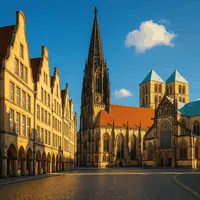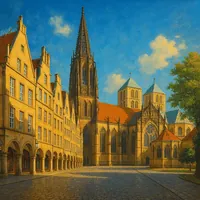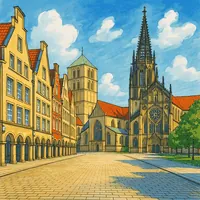Münster, North Rhine-Westphalia, stands apart as Germany’s unrivaled bicycle capital, where bikes outnumber residents and dedicated lanes weave through medieval streets. The Prinzipalmarkt’s arcaded facades, still bearing scars from the Anabaptist Rebellion, make its city center uniquely atmospheric. Home to the Peace of Westphalia treaties, Münster is a living symbol of European diplomacy and reconciliation.
Notable points about Münster
- Münster in North Rhine-Westphalia is uniquely defined by its deep-rooted tradition as Germany's "bicycle capital," with more bikes than residents and an extensive cycling infrastructure.
- Unlike many other German cities, Münster's Altstadt (Old Town) was meticulously rebuilt in traditional style after WWII, preserving a medieval ambiance with modern vibrancy.
- Spring and early summer (April–June) are ideal for visiting, with outdoor cafes, bike rides along Aasee Lake, and the Skulptur Projekte (held every 10 years) adding artistic flair.
- Münster is moderately priced compared to Berlin or Munich, making it a smart choice for budget-conscious travelers seeking authentic German charm.
- Experience authentic Westphalian culture at the Wochenmarkt in Domplatz every Wednesday and Saturday, where locals buy fresh produce, cheese, and flowers in front of the cathedral.
- Try the region’s signature dish, Pfefferpotthast (pepper beef stew), or grab a seat at the historic Gasthaus Stuhlmacher for hearty local fare and beer beside Prinzipalmarkt.
- Walking and cycling are the best ways to explore, with the Promenade—a tree-lined loop around the city center—providing scenic, car-free access to major sights.
- Hidden in the Kreuzviertel district is Café Malik, a cozy local favorite for coffee and cake, just steps from quiet art galleries and leafy residential charm.
- Münster is exceptionally safe, with widespread English spoken among younger locals; polite greetings like “Guten Tag” and cash (not cards) are appreciated in smaller shops.
- Watch the astronomical clock strike noon in St. Paulus-Dom and hear its medieval chimes—it’s a spine-tingling moment that connects you to centuries of Münster history.



